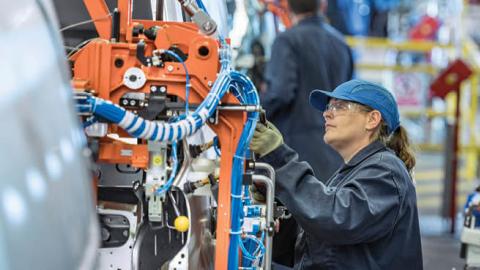The American economy is in a double bind. On the one hand, Covid-19 has made it necessary to reduce American dependence on China’s economy, and Chinese manufactured imports in particular. The alarm over China’s stranglehold on America’s access to important pharmaceuticals and health-care goods like ventilators is only the leading edge of this concern. According to the Los Angeles Times, there are no fewer than 62 bills pending in Congress to alter one aspect or another of our economic relationship with China.
Yet at the same time, if the U.S. isn’t prepared to deploy a reshoring strategy to restore itself as a manufacturing and industrial power, decoupling won’t do any good. In the 1960s, manufacturing made up 25% of U.S. gross domestic product. It’s barely 11% today. More than five million American manufacturing jobs have been lost 2000, the US has,and NAFTA as the cause since 2000.
Inevitably, discussion of how to bring home U.S. manufacturing leads to talk about industrial policy, especially in an election year. Hence we have Joe Biden’s recently announced Build Back Better initiative, which advocates spending $400 billion to spur demand for American products and services. Mr. Biden also proposes a $300 billion investment in scientific research on what he dubs “breakthrough technologies.” Half of this will be directed to clean-energy initiatives similar to those touted by the Obama administration. Solyndra strikes back.
Unfortunately, nothing in the Biden plan addresses the central problem, which is China. While reshoring American manufacturing isn’t a new concept (I published my first op-ed on the subject in 2012), the demand to decouple key sectors of the economy from China has made it an economic and national-security priority. In many sectors, decoupling will require federal assistance. Rather than throwing hundreds of billions of dollars at the problem, Washington should provide tax incentives, deregulation and highly targeted investment in research and development.
Another pandemic, or a deliberate biowarfare attack disguised as a viral contagion, could paralyze the U.S. economically and even militarily. Reducing American dependence on China-sourced pharmaceuticals and health-care products (which in the case of antibiotics means 97% of the current market) should therefore be a priority. But reviving the defense industrial base should also be a priority.
A 2018 White House Office of Trade and Manufacturing Policy study noted that, since 2000, America’s defense industry has shed more than 20,000 U.S.-based manufacturing companies. As the work those companies once did domestically has shifted overseas, much of it has gone to China. From rare-earth metals and permanent magnets to high-end electronic components and printed circuit boards, the Pentagon has slowly become dependent on Chinese industrial output. Asia produces 90% of the world’s circuit boards—more than half of them in China. The U.S. share of global circuit-board production has fallen to 5%.
In high-tech manufacturing, Washington needs to find ways to keep companies like Apple from relying on China for their production and supply chains. From robotics to drones, the U.S. lacks the capacity to manufacture many next-generation and emerging technologies. A single Chinese company, DJI, makes nearly 80% of the commercial drones currently in use in the U.S. and Canada.
But reshoring manufacturing isn’t only about plants, factories and shipyards. It’s also about a strong and resilient manufacturing workforce. This is why a reshoring strategy has to integrate the expertise of America’s private-sector labor unions, which have always understood that reshoring is good for workers as well as businesses—and good for America’s national security.
Likewise, U.S. industry needs to return research and development efforts to these shores. A 2015 study by consulting firms Strategy& and PwC found that U.S. companies were steadily moving their research-and-development centers to China to be closer to production, suppliers and engineering talent. A plan for developing a strong manufacturing R&D ecosystem in the U.S. needs to go beyond tax incentives and product wish-lists. Washington should identify commercial-sector technologies that may be crucial to national security. Artificial intelligence, robotics, quantum technologies and nanotechnology all need a strong domestic manufacturing base.
Any reshoring strategy that ignores the people who will perform vital research and engineering, now and in the future, is doomed to failure. A 2019 Congressional Research Service report found that India and China together made up nearly 70% of foreign students enrolled in STEM courses in the U.S. Many of those Chinese grads will bring their training home to benefit Beijing’s military-industrial complex. The U.S. can’t decouple from China without American education institutions working to build a homegrown cohort of scientists, engineers and high-tech researchers.
Finally, where reshoring manufacturing isn’t possible or desirable, the U.S. must look to allies like Japan, South Korea and India to become strong partners in building a reliable and secure supply chain for American business and industry, including the defense industrial base.
If the U.S. remains dependent on Chinese imports, the next pandemic could end up being far worse than Covid-19. The country may not survive a military conflict if its vital logistical sources are spread willy-nilly around the world, or controlled by a hostile power. Decoupling from China and reshoring manufacturing are America’s most pressing challenges. Getting both done requires a coherent strategy, not election-year sloganeering.
Read in the Wall Street Journal



















